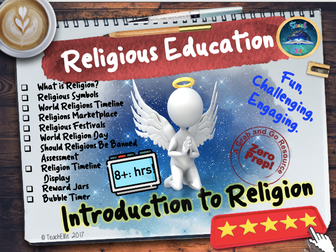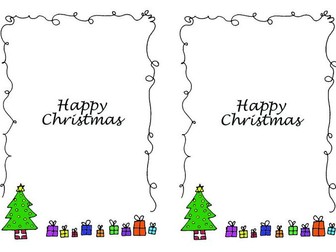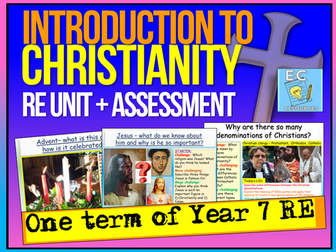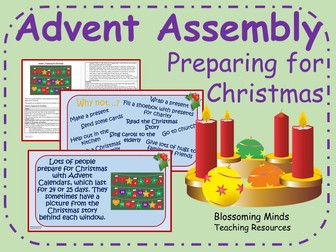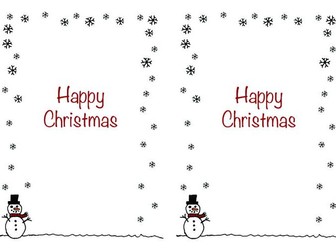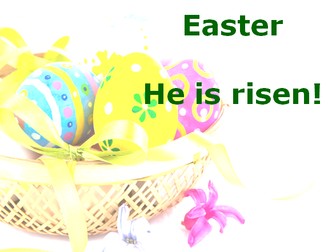Bundle

World Religions
This is an introduction unit used in Religious Education for year 7 pupils at the start of term. In this bundle there is:
Lesson 1: An intro to the six major world religions timeline- This lesson is the first in a set of seven designed to introduce pupils to the six of the major world religions. In this lesson, pupils will look at a timeline of the origins of religion, be tasked to recreate this timeline themselves (There are differentiated worksheets and a help sheet for lower ability pupils.) They will also have to colour a map of where the religions began.
There are links to 2 videos within this PPT. The second gives and overview of 5 world religions. The sixth pupils have to research for homework.
Lesson 2: What is Religion- This is the second lesson in a series of eight lessons on An Introduction to Religion.
In this lesson pupils are introduced to the concept of religion, they have to define the term themselves. They are then taken through the characteristics of religion.
Lesson 3 & 4: Religious Symbols- This is a ZERO PREP, Grab & Go Lesson!
It is the third in a set of eight designed to introduce pupils to the six of the major world religions. It has enough content to span two lessons.
In this lesson, pupils will discuss the meaning of the word ‘symbol’ and why we have symbols in everyday life (including religion). They will complete a symbols quiz.
The next activity takes them through the six major world religions and the basic of these religions. There are Religion ID cards included in this pack (three to a page or two to a page for lower ability. There is also further detail on the slides that follow this.
Plenary: Pupils have to complete an A-Z activity based on today’s learning.
Homework: pupils will be tasked with creating an origami booklet of the 6 major world religions. Includes our How To Make An Origami Booklet PPT
Lesson 5 & 6: Six Major World Religions - Marketplace-This is a ZERO PREP, Grab & Go Lesson!This resource is the fourth and fifth lesson in the series of eight into an ‘Introduction to Religion’. This series of lessons id designed to introduce pupils to the six of the major world religions.
This resource is designed to be taught over the course of two lessons. Usually pupils will research three religions per lesson, making a total of six religion researched over the course of two lessons.
The classroom should be set up into six groups, with resources based on each of the six major world religions. We usually place an iPad on each table along with any textbooks that we have relating to that religion so that pupils can research the religion independently in the given time frame.
There are two worksheets that the pupils can be given. There is a general two-sided worksheet with space for information on all six religions to be placed. There is also a more detailed fact sheet for pupils to fill in (one side of A4 for each religion). The choice is yours as to whether you give both worksheets to the pupils or just a single worksheet based on the ability of the class.
Lesson 7 : Religious Festivals- This is a ZERO PREP, Grab & Go Lesson!
This resource is the sixth and seventh lesson in the series of eight into an ‘Introduction to Religion’. This series of lessons is designed to introduce pupils to the six of the major world religions.
In this lesson pupils discuss the importance of festivals and under take a numeracy task based on this (there are differentiated worksheets provided in the pack). Pupils have to create an acrostic poem on the importance of festivals.
There are information cards included on religious festivals that are placed at the front of the class for pupils to ‘run’ up to collect and repeat the process once they have completed that section of the worksheet. There is a peer teaching section for pupils to teach each other the festivals in the religion they have researched and a peer assessment section.
This resource consists of: PowerPoint ( 33 slides) with a bell task, starter and plenary. Work Booklet (10 pages).
Lesson 8: Should Religious Symbols Be Banned? - This is a ZERO PREP, Grab & Go Lesson!
This resource is the eighth lesson in the series of an ‘Introduction to Religion’. This series of lessons is designed to introduce pupils to the six of the major world religions.
During this lesson pupils will have to undertake a comprehension assessment based on whether symbols should be banned. There is a survey activity for homework included in this pack also.
This resource consists of: PowerPoint (12 slides) with a bell task, starter and plenary. Work Booklet (9 pages).
Bonus Resources:
Bubble Timer-A fun countdown timer that can be used as a time management tool in any lesson. This is a 3 minute, 90 seconds and 60 second timer timer. Each bubble has been set to pop after 10 seconds (3 minute), 5 seconds (90 seconds) and 4 seconds (60 seconds) , but can easily be altered in the animation pane to make the timer shorter or longer. The bubbles can all be selected, copied from this presentation and pasted and inserted into your own or on top of any slide you wish!
Reward Jar-Behavior Management: This PowerPoint Contains two reward jars to use with your pupils to positively reinforce good behaviour. A great Visual behaviour management strategy!
Simply press the right arrow key to add an item to the jar and the left arrow key to delete it.
If you have any questions about this pleased do not hesitate to contact us via our Facebook page: TeachElite
#BACKTOSCHOOL
